Photo

As part of its shakedown, the new Inouye Solar Telescope has captured the surface of the sun in stunning new detail. Seen here are some of the sun’s turbulent convection cells, each about the size of the state of Texas. (Image and video credit: Inouye Solar Telescope)
#night#sky#stars#space#cosmos#solar system#sun#sol#gif#inouye solar telescope#astronomy#astrophotography#science#space facts#queue
1K notes
·
View notes
Text
youtube
Solar eclipse through Telescope
23 notes
·
View notes
Photo

In the arms of Andromeda by:Roberto Colombari
2K notes
·
View notes
Photo
Wikipedia: Messier 43 or M43, also known as De Mairan's Nebula and NGC 1982, is a star-forming nebula with a prominent H II region in the equatorial constellation of Orion. The De Mairan's Nebula is part of the Orion Nebula (Messier 42), being separated from the main nebula by a dense lane of dust known as the northeast dark lane. It is part of the much larger Orion Molecular Cloud Complex.
Right ascension: 05h 35m 31.8s
Declination: −05° 17′ 57″
Distance: 1600 ly
Apparent magnitude: (V)+9.0
Apparent dimensions: (V)20′ × 15′
Constellation: Orion
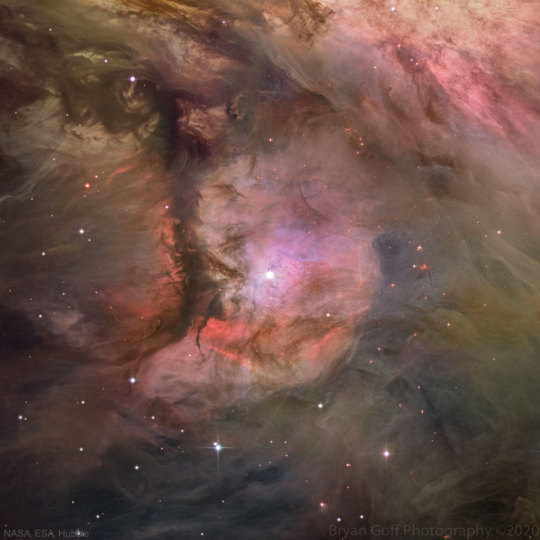
M43: Dust, Gas, and Stars in the Orion Nebula via NASA https://go.nasa.gov/2VRFUMh
127 notes
·
View notes
Photo

Chaos on Europa
This is a “Chaos terrain” observed by the Galileo spacecraft on the surface of Jupiter’s moon, Europa. Europa is fully covered by ice, but beneath that ice at a depth of maybe 100 kilometers the moon is thought to host a deep, liquid water ocean – heated by tidal interactions between Europa and 2 of Jupiter’s other moons Io and Ganymede.
Keep reading
#night#sky#stars#space#cosmos#solar system#moon#europa#astronomy#astrophotography#science#space facts#queue
108 notes
·
View notes
Photo



1) Composite image of Comet C/2020 F3 NEOWISE, captured by Marsha Kirschbaum in San Leandro, California, on the morning of July 5, 2020. She wrote: “It was a really early a.m. wakeup call for me. This icy celestial visitor survived its pass by the sun to put on a splendid show at 4:45 a.m. this morning. After a night and early morning of the dull background roar of fireworks punctuated by really loud ‘bombs’ with the smell of smoke, I was really doubtful I would see the comet because of the haze. And there was a lot of it as can be seen on the horizon in this image. I couldn’t quite see it with the unaided eye, but my 200 mm lens saw it just fine. My kind of celestial fireworks.”
2) Wide-sky view showing the location of Comet C/2020 F3 (NEOWISE) just before dawn on Monday, July 6, 2020, as seen from central U.S. facing northeast about 45 to 60 minutes before sunrise. Venus is the very bright planet, while Capella is a bright star seen towards the northeast now, at dawn. Illustration by Eddie Irizarry using Stellarium.
3) As a reminder, around mid-July, comet NEOWISE reappears early in the evening sky. This illustration shows location of the celestial visitor on July 15,2020. As seen from the central U.S., facing northwest just after sunset. Illustration by Eddie Irizarry using Stellarium.
Comet C/2020 F3 (NEOWISE) was discovered on March 27, 2020, from some 326 miles (525 km) above Earth’s surface by NEOWISE, the Near Earth Object Wide-field Infrared Survey Explorer, which is a space telescope launched by NASA in 2009.
Comet NEOWISE was closest to the sun on July 3, 2020, passing at about 26.7 million miles (43 million km) from the sun, or a bit closer than the average distance from the sun to Mercury. Observers are still reporting seeing it, and so it appears to have survived the close encounter with our star.
Comet C/2020 F3 (NEOWISE) is up at dawn now and should remain in the dawn sky until around July 11. Then it will temporarily disappear below the horizon while making a transition to the early evening sky, becoming visible again in the evening around July 15-16.
If the comet remains relatively bright, it might be easier to see in the second half of July during evening dusk, because, at that time, it will appear somewhat higher in the sky.
During the first days of July, Comet NEOWISE is a little tricky to catch because it appears not against a dark sky, but very close to the northeastern horizon just as dawn is brightening the sky.
More info, charts, how to view: https://earthsky.org/space/how-to-see-comet-c2020-f3-neowise
74 notes
·
View notes
Photo
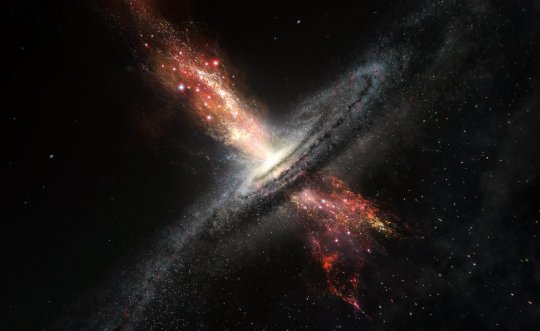


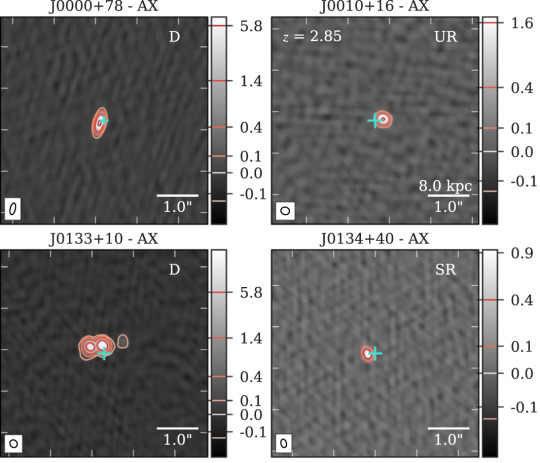
AAS NOVA
A Young Population of Hidden Jets
By Susanna Kohler
Looking for a fireworks show this 4th of July? Try checking out the distant universe, where powerful jets flung from supermassive black holes slam into their surroundings, lighting up the sky.
Though these jets are hidden behind shrouds of gas and dust, a new study has now revealed some of these young powerhouses.
A Galaxy–Black-Hole Connection
In the turbulent centers of active galaxies (active galactic nuclei, or AGN), gas and dust rains onto supermassive black holes of millions to billions of solar masses, triggering dramatic jets that plow into the surrounding matter and light up across the electromagnetic spectrum.
The growth of a supermassive black hole is thought to be closely tied to the evolution of its host galaxy, and feedback like these jets may provide that link. As the jets collide with the gas and dust surrounding the galaxy’s nucleus, they can trigger a range of effects — from shock waves that drive star formation, to gas removal that quenches star formation.
To better understand the connections between supermassive black holes and their host galaxies, we’d especially like to observe AGN at a time known as Cosmic Noon. This period occurred around 10 billion years ago and marks a time when star formation and supermassive black hole growth was at its strongest.
The Hidden World of Cosmic Noon
But there’s a catch: around Cosmic Noon, galaxies were heavily shrouded in thick gas and dust. This obscuring material makes it difficult for us to observe these systems in short wavelengths like optical and X-ray. Instead, we have to get creative by searching for our targets at other wavelengths.
Since AGN emission is absorbed by the surrounding dust and re-radiated in infrared, we can use infrared brightness to find obscured but luminous sources. To differentiate between hidden clumps of star formation and hidden AGN, we also look for a compact radio source — a signature that points to a jet emitted from a central black hole.
A team of scientists led by Pallavi Patil (University of Virginia and the National Radio Astronomy Observatory) has now gone on the hunt for these hidden sources at Cosmic Noon.
Newly-Triggered Jets Caught in the Act
Patil and collaborators observed a sample of 155 infrared-selected sources, following up with high-resolution imaging from the Jansky Very Large Array to identify compact radio sources. From their observations and modeling of the jets, the authors estimate these sources’ properties.
The authors find bright luminosities, small sizes, and high jet pressures — all of which suggest that we’ve caught newly-triggered jets in a short-lived, unique phase of AGN evolution where the jets are still embedded in the dense gas reservoirs of their hosts. The jets are expanding slowly because they have to work hard to push through the thick clouds of surrounding material. Over time, the jets will likely expand to larger scales and clear out the surrounding matter, causing the sources to evolve into more classical looking radio galaxies.
What’s next? The authors are currently working on a companion study to further explore the shapes of the jets and their immediate environments. These young, hidden sources will provide valuable insight into how supermassive black holes evolve alongside their host galaxies.
Citation
“High-resolution VLA Imaging of Obscured Quasars: Young Radio Jets Caught in a Dense ISM,” Pallavi Patil et al 2020 ApJ 896 18. doi:10.3847/1538-4357/ab9011
TOP IMAGE….Artist’s impression of a galaxy forming stars, as powerful jets that are flung from its central black hole collide with the surrounding matter. [ESO/M. Kornmesser]
CENTRE IMAGE….This composite image of Centaurus A shows an example of large-scale jets launched from an AGN, which can eventually extend far beyond the galaxy, as seen here. [ESO/WFI (Optical); MPIfR/ESO/APEX/A.Weiss et al. (Submillimetre); NASA/CXC/CfA/R.Kraft et al. (X-ray)]
LOWER IMAGE….The redshift distribution of the authors’ sample, based on spectroscopic redshifts of 71 sources. The sources span the period of peak star formation and black hole fueling around Cosmic Noon. [Patil et al. 2020]
BOTTOM IMAGE….The JVLA 10 GHz radio continuum observations for four sources in the authors’ sample. The cyan plus symbol marks the infrared-obtained source position. The color bars indicate flux in mJy/beam. [Adapted from Patil et al. 2020]
#night#sky#stars#space#cosmos#nova#black hole#quasar#astronomy#astrophotography#astrophysics#science#space facts#queue
170 notes
·
View notes
Photo

M100 and Hubble’s Repair
When Hubble was first placed in space, a issue with it’s mirrors blurred the telescopes images. A space walk to fix the issue was a huge success, and a crystal clear image of M100 Galaxy sprung into life.
Fast forward over 25 years later, and an upgrade carried out in 2009 to add the Hubble’s Wide Field Camera 3, took a further leap in quality.

M100 is 55 Million light years away and part of the Virgo super cluster of galaxies (which our Milky Way is also a member) with the massive M87 elliptical galaxy making up one of the main galaxies in that group (of recent Black Hole image fame !).
Source : https://astronomynow.com/2020/06/15/hubbles-before-and-more-recent-after-image-of-m100/
#night#sky#stars#space#cosmos#galaxy#galaxies#hubble#hubble space telescope#astronomy#astrophotography#science#space facts#queue
186 notes
·
View notes
Text
Black holes
A black hole is a region of spacetime exhibiting such strong gravitational effects that nothing—not even particles and electromagnetic radiation such as light—can escape from inside it. The theory of general relativity predicts that a sufficiently compact mass can deform spacetime to form a black hole. The boundary of the region from which no escape is possible is called the event horizon. Although the event horizon has an enormous effect on the fate and circumstances of an object crossing it, no locally detectable features appear to be observed. In many ways a black hole acts like an ideal black body, as it reflects no light.
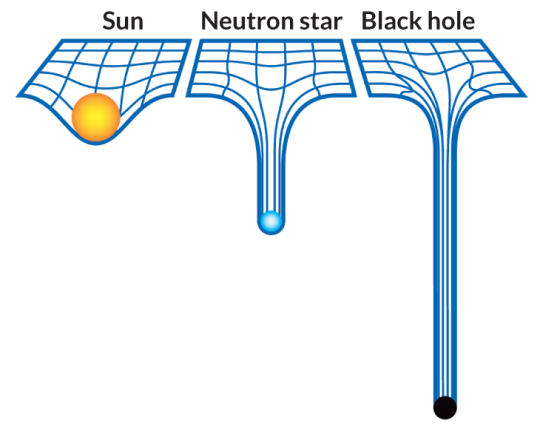
The idea of a body so massive that even light could not escape was briefly proposed by astronomical pioneer and English clergyman John Michell in a letter published in November 1784. Michell’s simplistic calculations assumed that such a body might have the same density as the Sun, and concluded that such a body would form when a star’s diameter exceeds the Sun’s by a factor of 500, and the surface escape velocity exceeds the usual speed of light.
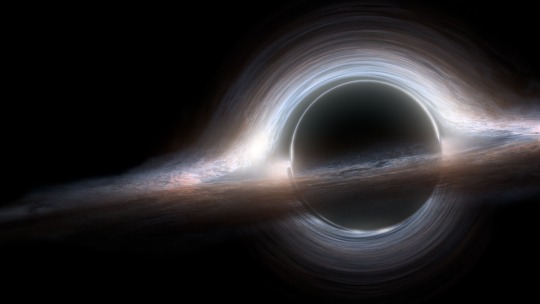
At the center of a black hole, as described by general relativity, lies a gravitational singularity, a region where the spacetime curvature becomes infinite. For a non-rotating black hole, this region takes the shape of a single point and for a rotating black hole, it is smeared out to form a ring singularity that lies in the plane of rotation. In both cases, the singular region has zero volume. It can also be shown that the singular region contains all the mass of the black hole solution. The singular region can thus be thought of as having infinite density.

How Do Black Holes Form?
Scientists think the smallest black holes formed when the universe began.
Stellar black holes are made when the center of a very big star falls in upon itself, or collapses. When this happens, it causes a supernova. A supernova is an exploding star that blasts part of the star into space.

Scientists think supermassive black holes were made at the same time as the galaxy they are in.
Supermassive black holes, which can have a mass equivalent to billions of suns, likely exist in the centers of most galaxies, including our own galaxy, the Milky Way. We don’t know exactly how supermassive black holes form, but it’s likely that they’re a byproduct of galaxy formation. Because of their location in the centers of galaxies, close to many tightly packed stars and gas clouds, supermassive black holes continue to grow on a steady diet of matter.

If Black Holes Are “Black,” How Do Scientists Know They Are There?
A black hole can not be seen because strong gravity pulls all of the light into the middle of the black hole. But scientists can see how the strong gravity affects the stars and gas around the black hole.
Scientists can study stars to find out if they are flying around, or orbiting, a black hole.

When a black hole and a star are close together, high-energy light is made. This kind of light can not be seen with human eyes. Scientists use satellites and telescopes in space to see the high-energy light.
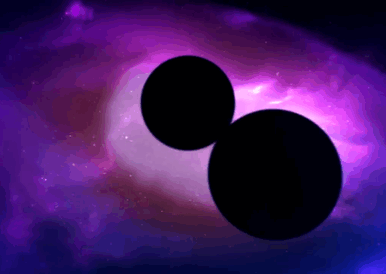
On 11 February 2016, the LIGO collaboration announced the first observation of gravitational waves; because these waves were generated from a black hole merger it was the first ever direct detection of a binary black hole merger. On 15 June 2016, a second detection of a gravitational wave event from colliding black holes was announced.
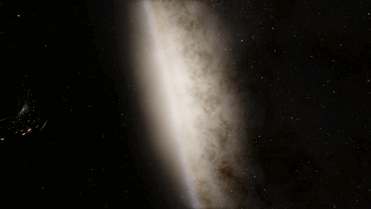
Simulation of gravitational lensing by a black hole, which distorts the image of a galaxy in the background
Animated simulation of gravitational lensing caused by a black hole going past a background galaxy. A secondary image of the galaxy can be seen within the black hole Einstein ring on the opposite direction of that of the galaxy. The secondary image grows (remaining within the Einstein ring) as the primary image approaches the black hole. The surface brightness of the two images remains constant, but their angular size varies, hence producing an amplification of the galaxy luminosity as seen from a distant observer. The maximum amplification occurs when the background galaxy (or in the present case a bright part of it) is exactly behind the black hole.
Could a Black Hole Destroy Earth?
Black holes do not go around in space eating stars, moons and planets. Earth will not fall into a black hole because no black hole is close enough to the solar system for Earth to do that.

Even if a black hole the same mass as the sun were to take the place of the sun, Earth still would not fall in. The black hole would have the same gravity as the sun. Earth and the other planets would orbit the black hole as they orbit the sun now.
The sun will never turn into a black hole. The sun is not a big enough star to make a black hole.
More posts about black holes
Source 1, 2 & 3
8K notes
·
View notes
Photo

Comet Swan
Just as Comet Atlas disappointed, breaking up before it could attain a brightness to become visible to the naked eye, in comes Comet Swan.
Now visible in the early morning sky (Northern hemisphere), although best viewed with binoculars, we finally get our May Comet.
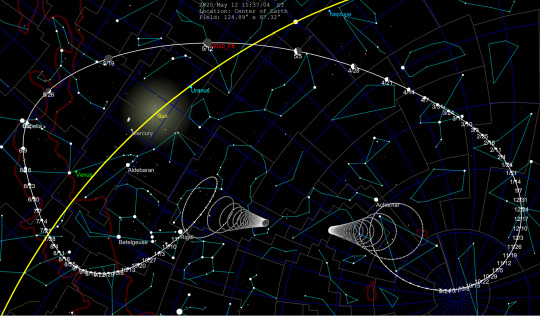
Currently in the constellation of Triangulum, and magnitude 5.7-6, the Comet has now passed it’s closest approach and will continue outwards out of the solar system, back to the Oort cloud.
#night#sky#stars#space#cosmos#comet#solar system#astronomy#astrophotography#science#space facts#queue
198 notes
·
View notes
Photo

Neptune and its moons (Proteus, Larissa, Despina and Galatea)
Credit: NASA / Hubble (infrared)
#night#sky#stars#space#cosmos#solar system#planets#moon#neptune#proteus#larissa#despina#galatea#astronomy#astrophotography#science#space facts#queue
44K notes
·
View notes
Photo
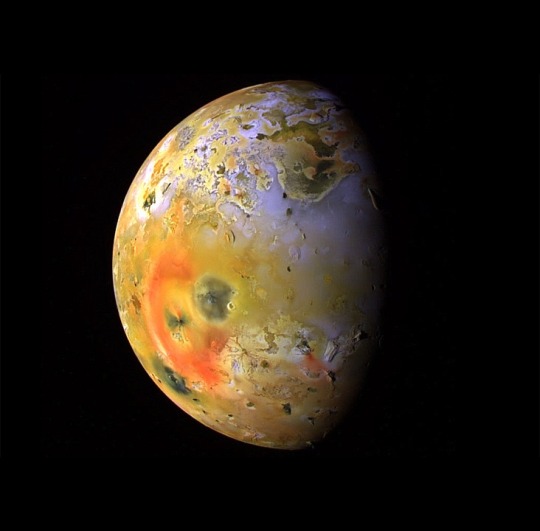
This view of Jupiter’s moon Io was captured by NASA’s Galileo spacecraft. Slightly larger than Earth’s moon, Io is the most volcanically active body in the solar system.
Credit: NASA/JPL/University of Arizona
#night#sky#stars#space#cosmos#solar sytem#moon#io#jupiter#astronomy#astrophotography#science#space facts#queue
7K notes
·
View notes
Photo
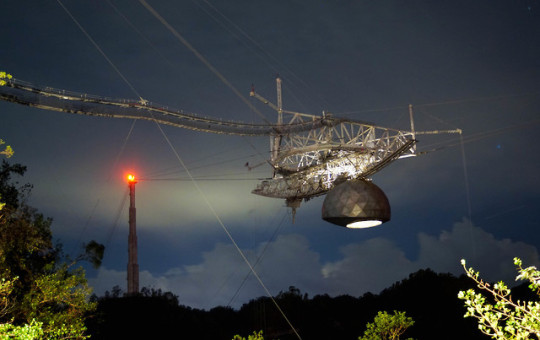





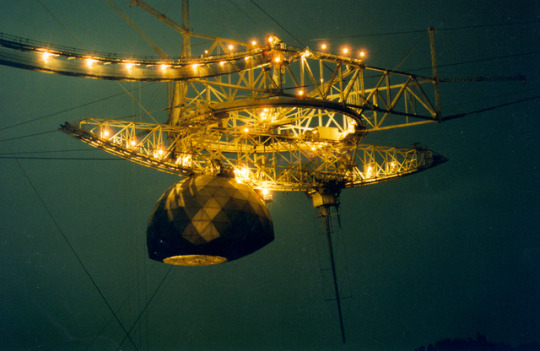
Arecibo Observatory
The Arecibo Observatory is a radio telescope in the municipality of Arecibo, Puerto Rico. This observatory is operated by University of Central Florida, Yang Enterprises and UMET, under cooperative agreement with the US National Science Foundation (NSF). The observatory is the sole facility of the National Astronomy and Ionosphere Center (NAIC), which is the formal name of the observatory. From its construction in the 1960s until 2011, the observatory was managed by Cornell University.
For more than 50 years, from its completion in 1963 until July 2016 when the Five hundred meter Aperture Spherical Telescope (FAST) in China was completed, the Arecibo Observatory’s 1,000-foot (305-meter) radio telescope was the world’s largest single-aperture telescope. It is used in three major areas of research: radio astronomy, atmospheric science, and radar astronomy.
Many scientific discoveries have been made with the observatory. On April 7, 1964, soon after it began operating, Gordon Pettengill’s team used it to determine that the rotation period of Mercury was not 88 days, as formerly thought, but only 59 days. In 1968, the discovery of the periodicity of the Crab Pulsar (33 milliseconds) by Lovelace and others provided the first solid evidence that neutron stars exist. (Crab pulsar sound by Arecibo Observatory)

In 1974, Hulse and Taylor discovered the first binary pulsar PSR B1913+16, an accomplishment for which they later received the Nobel Prize in Physics. In 1982, the first millisecond pulsar, PSR B1937+21, was discovered by Donald C. Backer, Shrinivas Kulkarni, Carl Heiles, Michael Davis, and Miller Goss. This object spins 642 times per second and, until the discovery of PSR J1748-2446ad in 2005, was identified as the fastest-spinning pulsar.
The Arecibo Message

In 1974, the Arecibo Message, an attempt to communicate with potential extraterrestrial life, was transmitted from the radio telescope toward the globular cluster Messier 13, about 25,000 light-years away. The 1,679 bit pattern of 1s and 0s defined a 23 by 73 pixel bitmap image that included numbers, stick figures, chemical formulas and a crude image of the telescope. source
#night#sky#stars#space#cosmos#arecibo observatory#astronomy#astrophotography#astrophysics#science#space facts#queue
1K notes
·
View notes
Photo

An eclipsing binary millisecond pulsar discovered by FAST
Using the data obtained by the Five-hundred-meter Aperture Spherical radio Telescope (FAST), a research team led by Prof. PAN Zhichen and Prof. LI Di from the National Astronomical Observatories of the Chinese Academy of Sciences (NAOC) discovered an eclipsing binary millisecond pulsar in Globular Cluster (GC) Messier 92 (M92).
Named as PSR J1717+4307A or M92A, it is the first pulsar known in M92, with a spinning period of 3.16 ms and a dispersion measure (DM) of 35.45 pc cm-3. Follow-up observations showed that this binary system is in a circular orbit with an orbital period of 0.2 day and a radius of 120 thousand kilometers. The companion is a 0.18 solar mass star, evolving to be a sub-giant.
Due to the compactness of the orbit, materials from the companion are being swallowed by the pulsar. Such a binary system is nicknamed a ‘redback’ spider. Like this type spider that the female ones tend to eat their companions, the pulsar tends to accrete the mass from the companion.
Since the discovery of the first pulsar in 1967, thousands of pulsars have been found in our Galaxy. While some are located in the Galactic plane, we’ve also observed a population of pulsars in GCs that orbit the Milky Way.
These pulsars are a useful tool for probing a very different environment: the dense stellar cores consisting of stars as old as 10 billion years. To date, there are 157 pulsars discovered in 30 GCs.
M92A was first detected on October 9, 2017, during the commissioning of FAST. With more than twice the collecting area of that of the Arecibo Telescope in Puerto Rico, more discoveries are expected from FAST and they will improve our understanding of the pulsar population in the Milky Way and of related astrophysics, such as massive stellar evolution and equation of state of condensed matters.
This work was published in Astrophysical Journal Letters on Mar. 19, and it was highlighted by the American Astronomy Society (AAS) Nova site on April 17, 2020.
172 notes
·
View notes
Text
Galaxies: Types and morphology
A galaxy is a gravitationally bound system of stars, stellar remnants, interstellar gas, dust, and dark matter. Galaxies range in size from dwarfs with just a few hundred million (108) stars to giants with one hundred trillion (1014) stars, each orbiting its galaxy’s center of mass.

Galaxies come in three main types: ellipticals, spirals, and irregulars. A slightly more extensive description of galaxy types based on their appearance is given by the Hubble sequence.

Since the Hubble sequence is entirely based upon visual morphological type (shape), it may miss certain important characteristics of galaxies such as star formation rate in starburst galaxies and activity in the cores of active galaxies.
Ellipticals

The Hubble classification system rates elliptical galaxies on the basis of their ellipticity, ranging from E0, being nearly spherical, up to E7, which is highly elongated. These galaxies have an ellipsoidal profile, giving them an elliptical appearance regardless of the viewing angle. Their appearance shows little structure and they typically have relatively little interstellar matter. Consequently, these galaxies also have a low portion of open clusters and a reduced rate of new star formation. Instead they are dominated by generally older, more evolved stars that are orbiting the common center of gravity in random directions.
Spirals

Spiral galaxies resemble spiraling pinwheels. Though the stars and other visible material contained in such a galaxy lie mostly on a plane, the majority of mass in spiral galaxies exists in a roughly spherical halo of dark matter that extends beyond the visible component, as demonstrated by the universal rotation curve concept.
Spiral galaxies consist of a rotating disk of stars and interstellar medium, along with a central bulge of generally older stars. Extending outward from the bulge are relatively bright arms. In the Hubble classification scheme, spiral galaxies are listed as type S, followed by a letter (a, b, or c) that indicates the degree of tightness of the spiral arms and the size of the central bulge.
Barred spiral galaxy

A majority of spiral galaxies, including our own Milky Way galaxy, have a linear, bar-shaped band of stars that extends outward to either side of the core, then merges into the spiral arm structure. In the Hubble classification scheme, these are designated by an SB, followed by a lower-case letter (a, b or c) that indicates the form of the spiral arms (in the same manner as the categorization of normal spiral galaxies).
Ring galaxy

A ring galaxy is a galaxy with a circle-like appearance. Hoag’s Object, discovered by Art Hoag in 1950, is an example of a ring galaxy. The ring contains many massive, relatively young blue stars, which are extremely bright. The central region contains relatively little luminous matter. Some astronomers believe that ring galaxies are formed when a smaller galaxy passes through the center of a larger galaxy. Because most of a galaxy consists of empty space, this “collision” rarely results in any actual collisions between stars.
Lenticular galaxy

A lenticular galaxy (denoted S0) is a type of galaxy intermediate between an elliptical (denoted E) and a spiral galaxy in galaxy morphological classification schemes. They contain large-scale discs but they do not have large-scale spiral arms. Lenticular galaxies are disc galaxies that have used up or lost most of their interstellar matter and therefore have very little ongoing star formation. They may, however, retain significant dust in their disks.
Irregular galaxy

An irregular galaxy is a galaxy that does not have a distinct regular shape, unlike a spiral or an elliptical galaxy. Irregular galaxies do not fall into any of the regular classes of the Hubble sequence, and they are often chaotic in appearance, with neither a nuclear bulge nor any trace of spiral arm structure.
Dwarf galaxy

Despite the prominence of large elliptical and spiral galaxies, most galaxies in the Universe are dwarf galaxies. These galaxies are relatively small when compared with other galactic formations, being about one hundredth the size of the Milky Way, containing only a few billion stars. Ultra-compact dwarf galaxies have recently been discovered that are only 100 parsecs across.
Interacting

Interactions between galaxies are relatively frequent, and they can play an important role in galactic evolution. Near misses between galaxies result in warping distortions due to tidal interactions, and may cause some exchange of gas and dust. Collisions occur when two galaxies pass directly through each other and have sufficient relative momentum not to merge.
Starburst
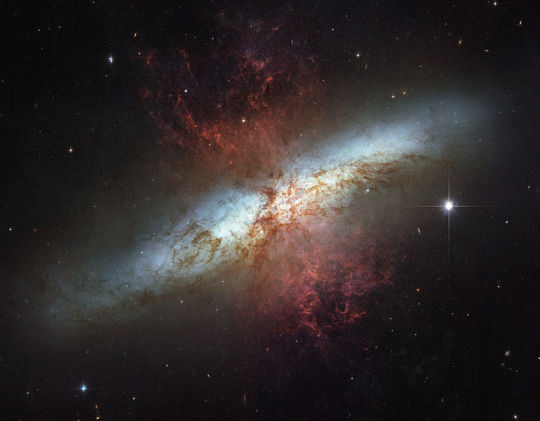
Stars are created within galaxies from a reserve of cold gas that forms into giant molecular clouds. Some galaxies have been observed to form stars at an exceptional rate, which is known as a starburst. If they continue to do so, then they would consume their reserve of gas in a time span less than the lifespan of the galaxy. Hence starburst activity usually lasts for only about ten million years, a relatively brief period in the history of a galaxy.
Active galaxy
A portion of the observable galaxies are classified as active galaxies if the galaxy contains an active galactic nucleus (AGN). A significant portion of the total energy output from the galaxy is emitted by the active galactic nucleus, instead of the stars, dust and interstellar medium of the galaxy.

The standard model for an active galactic nucleus is based upon an accretion disc that forms around a supermassive black hole (SMBH) at the core region of the galaxy. The radiation from an active galactic nucleus results from the gravitational energy of matter as it falls toward the black hole from the disc. In about 10% of these galaxies, a diametrically opposed pair of energetic jets ejects particles from the galaxy core at velocities close to the speed of light. The mechanism for producing these jets is not well understood.

The main known types are: Seyfert galaxies, quasars, Blazars, LINERS and Radio galaxy.
source
images: NASA/ESA, Hubble (via wikipedia)
#night#sky#stars#space#cosmos#galaxy#galaxies#astronomy#astrophotography#astrophysics#science#space facts#queue
8K notes
·
View notes
Photo



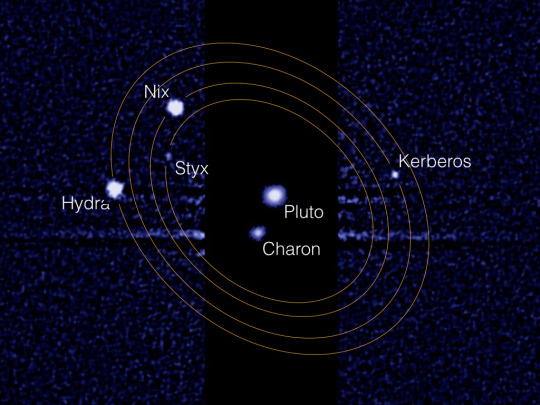



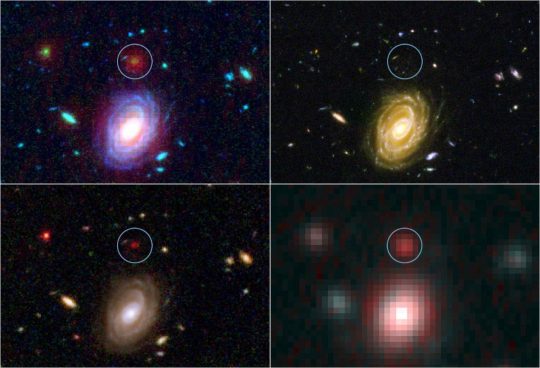


3 Big Lessons We Can All Learn On The Hubble Space Telescope’s 30th Anniversary
“Before Hubble, we did not know how fast the Universe was expanding. We did not know its age; we did not know how much matter was in it; we did not know whether its ultimate fate was to recollapse or expand forever. We did not know when stars and galaxies first formed, what the earliest ones were like, or the details of how stars were born and died. We did not even know whether there were planets in solar systems beyond our own.
30 years later, we have the answers to all of these questions, largely thanks to scientific contributions made using this one astronomical observatory. New questions have arisen in their place, as pushing the cosmic frontier back to new depths always leads to the discovery of novel phenomena that themselves require an explanation. The cosmic frontier is truly endless in this regard. May we always remain curious enough to investigate and solve whatever mysteries the Universe lays before us.”
Individually, across a myriad of issues from the Solar System to stars and galaxies to the ultra-distant Universe and the largest cosmic scales, Hubble has illuminated the Universe like no other observatory in history. But on an even grander intellectual scale, it’s exemplified three major scientific lessons that we should all remember in everything we do.
1.) Whenever you can, look as you’ve never looked before.
2.) Always follow the evidence, no matter where it leads.
3.) There is a ‘right way’ to be wrong.
On this occasion, the 30th anniversary of Hubble’s launch, take a look back at the biggest lessons it has to offer, and may we apply these moving forward in all we do.
#night#sky#stars#space#cosmos#hubble#hubble space telescope#nasa#astronomy#astrophotography#astrophysics#earth#earthpix#science#space facts#queue
415 notes
·
View notes
Photo

Open Arms by Hubble Space Telescope / ESA
#night#sky#stars#space#cosmos#galaxy#hubble space telescope#hubble#esa#european space agency#astronomy#astrophotography#queue
239 notes
·
View notes